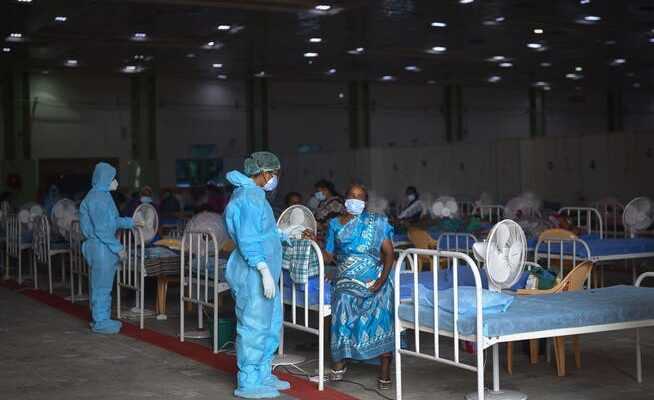BA.2 has now become established in Denmark and India. This variant is apparently even more contagious than BA.1. It is unclear whether it is more dangerous or harmless.
An emergency hospital for Covid 19 patients was set up in an exhibition hall in Chennai in the Indian state of Tamil Nadu in January. India reported more than 270,000 new infections per day in mid-January.
Although the Omicron variant only arrived in Europe and other regions of the world a few weeks ago, two distinct Omicron relatives are already vying for supremacy: Omicron BA.1 and Omicron BA.2. The former came first and now dominates the Corona events in many countries. But in Denmark, more than 50 percent of the new infections detected have been caused by BA.2 for a few days.
Apparently BA.2 is superior to BA.1 not only in Denmark. This is also the case in some other countries. India and the Philippines, for example, report that BA.2 has largely replaced the other Omicron variant. BA.2 is also on the rise in Sweden and Norway, and in Singapore it already accounts for a third of all new infections. So far, only about a thousand BA.2 cases have been discovered in the UK. However, local experts estimate that the proportion of BA.2 is currently doubling every four days – at the expense of BA.1.
There’s not any functional or epidemiological data to show any meaningful differences….yet. But BA.2 has become dominant in Denmark, out-competing BA.1, and its prevalence is rising in India, Singapore, Sweden, the UK and other countries /2 Graph via @Mike_Honey_ pic.twitter.com/eWIZ6cWmJc
— Eric Topol (@EricTopol) January 23, 2022
In Germany, too, the proportion of BA.2 cases has increased noticeably since mid-January. But since only very few Omicron BA.2 infections have been found in Germany and Switzerland, nothing can be said about a possible competition between BA.1 and BA.2 or even a winning variant.
BA.2 has been identified in around fifty countries worldwide. However, it is very likely that the proportion is significantly underestimated in many places. In contrast to BA.1, BA.2 lacks a special mutation in the spine protein. Thanks to this mutation, BA.1 can already be clearly identified as an omicron in the PCR test.
Although the PCR test also detects the presence of BA.2, it only reports: Sars-CoV-2 infection. A BA.2 infection can therefore only be clearly identified by sequencing the virus genome. But these decryptions are time-consuming and costly. Therefore, the virus of every infected person is not sequenced in any country.
Why BA.2 is even fitter and can spread even faster than BA.1 is currently unclear. Apparently, however, it is not due to the specific conditions of a country or region, i.e. the respective vaccination and recovery rate, the age of the population, the weather or the measures taken. Because BA.2 is spreading quickly in very different countries. However, experts do not expect that there will now be a second omicron wave. Rather, the infections of BA.1 and BA.2 would overlap.
small clarification – assuming BA.2 is antigenically similar but more transmissible its likely to exacerbate existing Omicron waves – think enhanced/drawn out peaks, and delays or even transient reversal of decreases – what it wont do is immediately cause a second, equal Omi wave
— Tom Peacock (@PeacockFlu) January 21, 2022
Nothing is yet known about any differences between the Covid-19 diseases triggered by the respective omicron variants. The Danish Statens Serum Institute reported a few days ago that so far there is no evidence that the hospitalization rate for those infected with BA.2 is different than for those who contracted BA.1.
However, it is quite conceivable that BA.2 causes a more severe or harmless Covid 19 disease. This is because BA.2 differs from BA.1 at seventeen locations in the genome. Many of these mutations are in the spike protein. So it may be that BA.2 escapes the immune response of vaccinated and recovered people even better. Or better able to penetrate into the human cell. All of this is now being explored.
Already three cousins
The large number of omicron variants, as well as the locations of the differences between them, clearly show that BA.2 did not arise from BA.1, so they are not mother and daughter, but cousins.
It is precisely this fact that now increases the mystery surrounding the origin of Omicron. Genetic analyzes have shown that the omicron ancestor probably arose in early summer 2020. No one knows where exactly – nor why it remained undiscovered until November 2021. However, several omicron offshoots apparently formed during this period, which then circulated in southern Africa largely at the same time and were later discovered.
The end of the Omikron development is far from in sight. Some countries, including Poland and South Africa, are already reporting the presence of Omikron BA.3.
